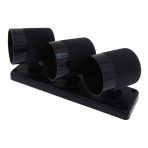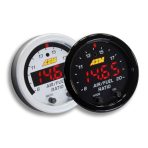Gauges, Pods & Accessories
Our Gauges, Pods & Accessories hub covers everything for clean installs and accurate data. Pick clear gauges, sturdy pods, and matched sensors/adapters. Start with Gauges & Meters and Gauge Pods & Accessories. With standard 1/8 NPT/BSP threads and complete fittings, installation is fast and reliable.
Brief summary + key benefits
The Gauges, Pods & Accessories category lets you build a complete, reliable monitoring setup. Pair accurate gauges with solid pods and matched sensors/adapters. Stepper movements, peak/warning and wideband AFR/EGT options help you react early and protect the engine.
Technical Basics
Common sender threads are 1/8 NPT (taper) and 1/8 BSP (parallel). Temperature senders are NTC-based; EGT uses K-type thermocouples; boost comes via MAP sensors or vacuum lines. Pods (ABS/fibreglass) mount on the A-pillar, dash or steering column; aim 10–20° toward the driver for a quick glance. Use star-grounding and shielded wiring to reduce electrical noise. Inline coolant housings (32–40 mm) and oil sandwich plates simplify plumbing.
Need sender/fitting details? See: Sensors, Adapters & Accessories.
Selection Criteria
Use case: street builds prioritise readability and warnings; track cars benefit from stepper gauges and larger 60 mm faces. Typical turbo setups monitor boost, oil pressure and temps; advanced tuning adds EGT and AFR.
Placement: A-pillar and upper dash are easiest to scan; column mounts are discreet. Never obstruct side-airbag deployment.
Compatibility: match sender signal, thread and range to the gauge/ECU. Standard sizes are 52/60 mm; pods come in single/dual/triple layouts with matte finishes to cut glare.
Installation & Maintenance
Test-fit, mark holes/cable routes, degrease surfaces and use 3M acrylic tape or screws (with rubber washers). Fuse power feeds, tap illumination from sidelights and verify grounds. After plumbing, bleed coolant circuits and build oil pressure before first start. Weld EGT bungs and heat-shield the leads. Re-torque mounts and inspect seals after heat cycles; perform periodic wideband free-air calibration.
FAQ
52 mm or 60 mm?
52 mm fits everywhere; 60 mm improves visibility if the panel allows it.
Electronic vs mechanical pressure?
Electronic keeps fluids out of the cabin and provides steadier readings—choose it for safety.
Where to place EGT?
Upstream of the turbine (40–90 cm), angled into flow; protect the probe lead from heat.
Do I need warning/peak functions?
Yes—warnings catch issues at a glance and peak recall helps post-run analysis.




